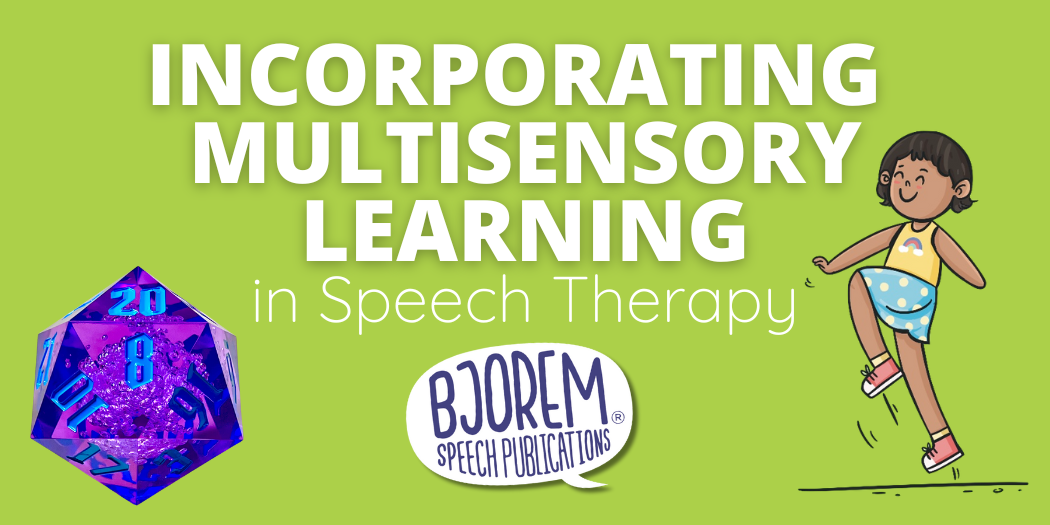The Importance of Multisensory Learning for Kids
Multisensory learning is an educational approach that engages more than one sense at a time. This method is especially beneficial for young learners, as it helps to solidify their understanding and retention of new information. Incorporating multisensory techniques into speech therapy can make learning more effective and enjoyable for children.
Why Multisensory Learning Matters
1. Enhances Memory and Retention: Engaging multiple senses helps to reinforce memory pathways in the brain. For example, when children see, hear, and touch something, they are more likely to remember it. This is particularly important in speech therapy, where the goal is often to teach children new sounds, words, and communication strategies.
2. Supports Different Learning Styles: Every child is unique and learns differently. Some children are visual learners, others are auditory learners, and some are kinesthetic learners who learn best through movement and touch. Multisensory learning caters to all these styles, ensuring that no child is left behind.
3. Improves Focus and Engagement: Multisensory activities are often more engaging and fun for children. This increased engagement can lead to better focus and more effective learning.
Multisensory Activities to Use in Your Next Speech Therapy Session
1. Sensory Bins
- Activity: Create a sensory bin filled with various textured items (e.g., rice, sand, water beads) and hide objects or Bjorem Speech ® picture cards that has the child's target sound.
- How It Works: Children search for items in the bin and then practice saying the name of each item they find.
- Senses Engaged: Tactile (touching the sensory items), visual (seeing the objects), auditory (hearing the words).
Check out our speech sound disorders decks that would pair perfectly with this!
2. Articulation Hopscotch
- Activity: Draw a hopscotch grid on the ground and place target words or sounds in each square.
- How It Works: Children hop on the squares and say the word or sound they land on.
- Senses Engaged: Kinesthetic (movement), visual (seeing the words/sounds), auditory (saying the words/sounds).
Check out our speech sound disorders decks that would pair perfectly with this!
3. Musical Chairs with a Twist
- Activity: Play a version of musical chairs where each chair has a picture card with a target sound or word.
- How It Works: When the music stops, children sit in a chair and say the sound or word on the card.
- Senses Engaged: Auditory (listening to music and saying words), kinesthetic (moving around), visual (seeing the cards).
Check out our speech sound disorders decks that would pair perfectly with this!
4. Flashlight Find
- Activity: Turn off the lights and use a flashlight to find picture cards or objects hidden around the room.
- How It Works: Children use the flashlight to find items and practice saying the target words or sounds.
- Senses Engaged: Visual (finding items with the flashlight), auditory (saying words/sounds), tactile (holding the flashlight).
Check out our speech sound disorders decks that would pair perfectly with this! Or, pair the Better Letters decks with the Laurie Berkner Better Letters songs- pause the music after each sound is introduced in the song and have the child find the cards that match!
5. Sand or Salt Writing
- Activity: Fill a tray with sand or salt and have children write letters, words, or sentences in the sand with their fingers.
- How It Works: The tactile experience of tracing letters in the sand helps reinforce letter formation and spelling.
- Senses Engaged: Tactile (feeling the sand), visual (seeing the letters).
Use this activity paired with our Better Letters decks and music!
6. Letter and Word Manipulatives
- Activity: Use magnetic letters, letter tiles, or word cards to build words and sentences on a magnetic board or table.
- How It Works: Manipulating physical letters helps children understand the structure of words and improves spelling skills.
- Senses Engaged: Tactile (handling letters), visual (seeing the letters and words).
Use this activity paired with our Better Letters decks and music!
7. Sound and Letter Matching
- Activity: Use Bjorem Speech® Sound Cue Cards or other picture cards to match sounds with their corresponding letters.
- How It Works: Children look at the picture, say the sound, and find the matching letter, reinforcing the connection between sounds and letters.
- Senses Engaged: Visual (seeing pictures and letters), auditory (saying sounds), tactile (handling cards).
8. Dice Roll Articulation with the Bjorem Big Roller
- Activity: Assign a target sound or word to each number on the dice or use the number to represent the number of trials on each turn.
- How It Works: Children roll the giant dice and practice the target sound or word the number of times indicated by the roll. For example, if they roll a five, they say the target word five times. Get creative with different movements towards the dice to see the number it landed on (run, jump, crab walk, army crawl, etc.)
- Senses Engaged: Visual (seeing the numbers), auditory (saying the words), kinesthetic (rolling the dice and going after it), tactile (handling the dice - it has some weight to it!).
Conclusion
Multisensory learning is a powerful approach that can significantly enhance a child’s educational experience, particularly in speech therapy. By engaging multiple senses, children are more likely to retain information, stay focused, and enjoy the learning process. At Bjorem Speech®, we are dedicated to creating inclusive, FUNctional, and research-based materials that make learning an engaging and effective experience for every child.
Check out some more of these sensory products!


